When I was returning the photos of Margot and Guinness from yesterday’s post to their photo album, I idly continued to look through it. It’s one of the albums with photos from 2001. I came to a page with a card that Timmy sent me, and he said it was okay if I shared it. It was postmarked September 5, 2001. Reading it, I’m sure what prompted Timmy to send it was that we became friends in September 1997.
 My dearest Becky,
My dearest Becky,
Just taking a break at work to write on one of the cards I bought in Provincetown. I’d almost forgotten what it felt like to be relaxed. Can you believe that four years have gone by so quickly? And what fantastic years they’ve been. I just want you to know what you mean to me, how dear our friendship is to me. I feel honored to have shared life on this planet with you. All right, enough of that emotional stuff. Here are the sunflowers on our roof–please disregard the dying palm in the background– Love you much, Timothy
I went to Timmy’s Manhattan apartment once. I remember the narrow, steep stairs that led to the rooftop garden. Like Timmy, Tim just bounded up and down those stairs as if they were nothing. I, on the other hand, have taken two hard falls down stairs, one that broke my arm. I’m cautious. Overly so. It’s a lack of confidence in my own balance. Sometimes, I am an old woman. So when I came down those stairs, I said, “You know, I’m just gonna sit and scoot down these stairs on my butt. DON’T WATCH.” And the boys didn’t make fun of me, just another of a million reasons why I love them. When they went up again later, probably to smoke, I said, “No, thanks! I’ll just sit down here and remember the view.”
In Timmy’s Polaroid, I can see the latticework that encloses his rooftop garden. A building of about the same height close by, and a residential high-rise in the distance. Clear skies. Timmy’s sky.
Six days after that card was mailed, Timmy walked to work. He knew a plane had hit the first tower, but he followed his routine. When he arrived–about six blocks from the World Trade Center site, he realized some of his coworkers were freaking out, unsure whether they should be there or not. They decided to close and go home. He walked to his apartment. He and Jean-Marc stood on the street and looked south. Jean-Marc, as always, had his camera. I don’t know how many photos J-M took; if I extrapolate information from some of the poetry Timmy has sent me (it’s always risky to assume a voice in any piece of writing is the same as its author’s), there is this:
…you have brought light to the darkest hour
(this of course, no ordinary event)
somehow capturing a high spirit
while the world crumbled one morning
you caught the immediate reaction of everyone running to help, to comfort…
Timmy e-mailed this photo; he titled it “Mirror.” J-M caught a stranger’s reflection in a rearview mirror as they all stared toward the towers.
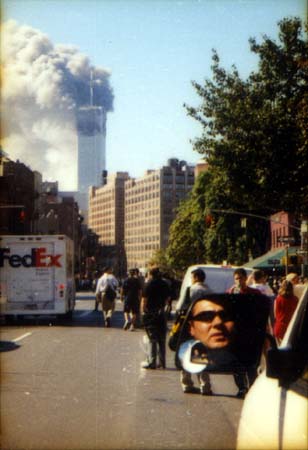
Photo copyright Jean-Marc Chazy, all rights reserved.
While they watched, the first tower fell, and people, many of them in business suits, began emerging from the smoke, covered in ash and dust. Timmy told me the rest of that day is a blank.
Today, talking to him on the phone, I asked, “Jean-Marc’s photo: Was that taken with a cell phone?” “His camera,” Timmy answered and reminded me that in 2001, we weren’t all armed with smart phones or even cell phones able to take photos.
In another phone conversation recently, this one with Jim and Bill, Bill spoke of how important it is for people who are gifted with words to record that time. He worried that because people now do capture everything with their cell phones then put it online before moving to the next story, we are forgetting the measured, reflective nature of writing our history.
More from Timmy’s poetry:
the view down Sixth
is missing…
I go to the roof to watch the flowers break
their stems and drop their heads.
They have time to prepare
their deaths.
The sun can’t warm the air as
Before, through
smoke,
memory,
electricity,
insulation,
charred plastic,
melting metal,
three thousand office chairs.
I think some of us have been writing for a long time. If sometimes we aren’t ready to share it, maybe even more true is that sometimes we still struggle to read it.
But I will always read Timmy. I’m so glad we became friends that September in 1997, and I value the maturing and deepening of that friendship fifteen years later. What Timmy’s speaker said in his poetry, I could say to him:
I am so grateful you share it with me
to laugh, to sob, to feel
to invite me in to your lens
Happy anniversary, my friend.
Except where noted, the poetry and photo in this post are copyrighted to Timothy Forry. Stealing is wrong.
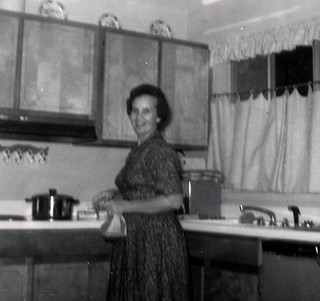
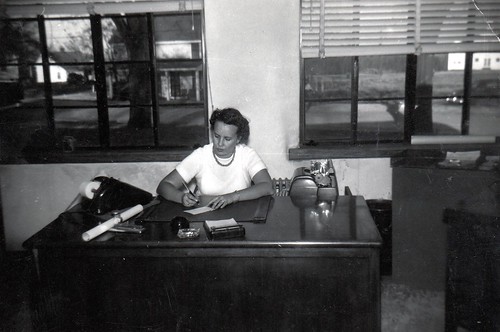
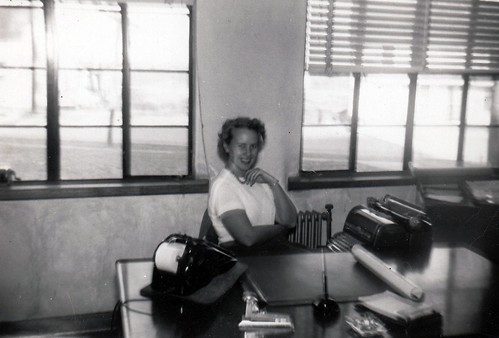
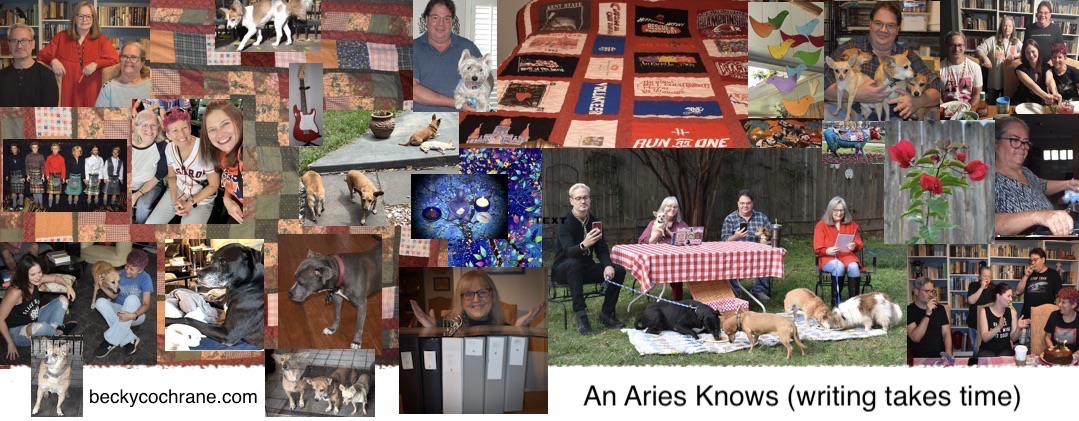
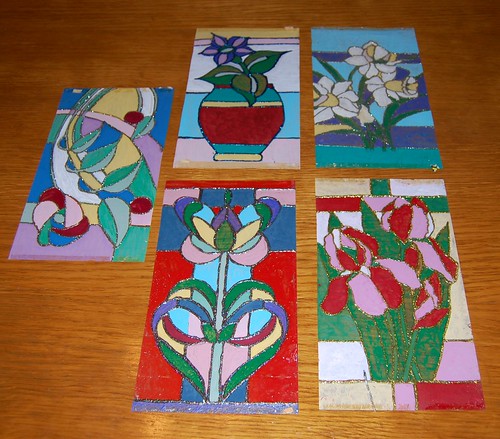
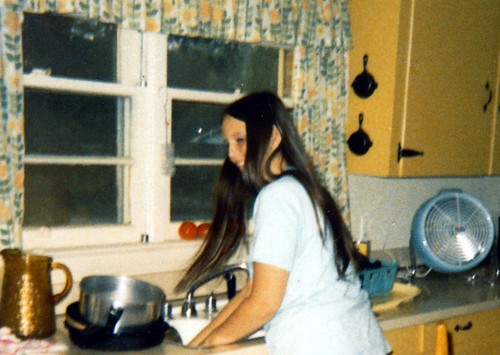
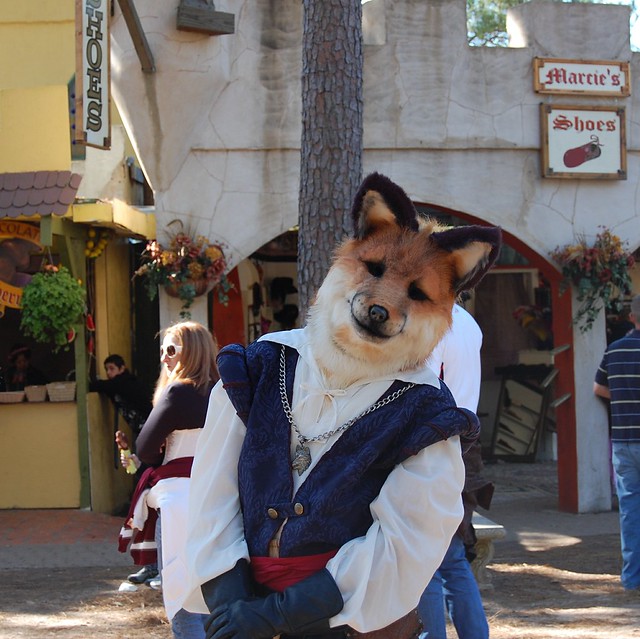
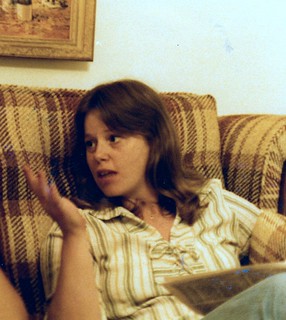
 Lynne’s sister Liz was a scientist. Her interests were many and varied; she once took a trip to the Galapagos Islands as scientists and naturalists are wont to do. She loved entomology and could often be found at night chasing down insects and moths. She was my go-to person for a long time on questions relating to all kinds of science and medicine. She was a gifted teacher whose enthusiasm was informative and inspiring.
Lynne’s sister Liz was a scientist. Her interests were many and varied; she once took a trip to the Galapagos Islands as scientists and naturalists are wont to do. She loved entomology and could often be found at night chasing down insects and moths. She was my go-to person for a long time on questions relating to all kinds of science and medicine. She was a gifted teacher whose enthusiasm was informative and inspiring. “Can I have this? Please? Huh? Can I have it? Is that okay? I want it. Do you mind?” I babbled, as if there were a pack of Petrologist Wolves outside Liz’s rural Pennsylvania door howling, “We must get our paws on that 1992 Audubon Society Field Guide to North American Rocks and Minerals RIGHT NOW, whatever the cost! With it, we can rule the planet!”
“Can I have this? Please? Huh? Can I have it? Is that okay? I want it. Do you mind?” I babbled, as if there were a pack of Petrologist Wolves outside Liz’s rural Pennsylvania door howling, “We must get our paws on that 1992 Audubon Society Field Guide to North American Rocks and Minerals RIGHT NOW, whatever the cost! With it, we can rule the planet!”
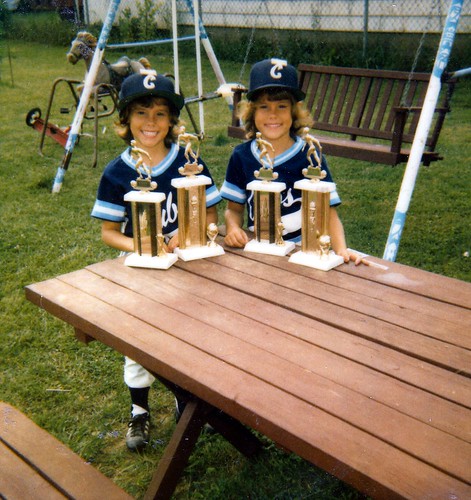
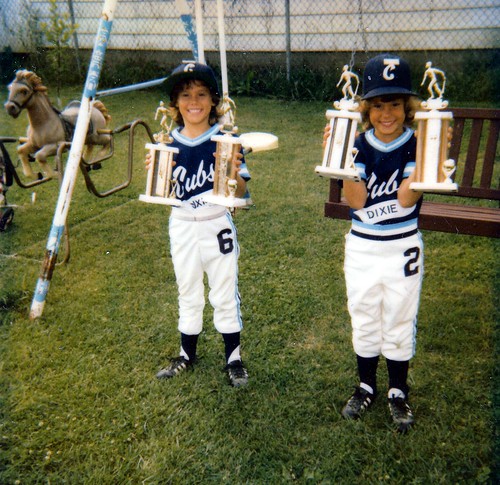

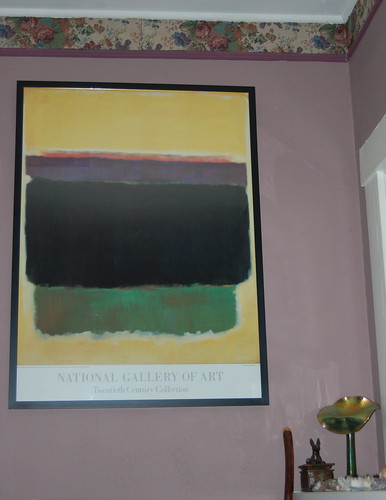


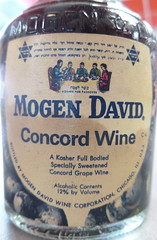 My Uncle Gerald occasionally had a glass of Mogen David. I adored him, and I’d never seen wine before, so I asked if I could taste it. I have no idea what age I was–maybe twelve? He exchanged a glance with my mother, handed me his glass, and I took a sip. Of course, I loved it. It’s a very sweet dessert wine and my palate was geared toward Kool-Aid. From then on, I was always allowed one sip from his glass on the rare occasion that he poured one.
My Uncle Gerald occasionally had a glass of Mogen David. I adored him, and I’d never seen wine before, so I asked if I could taste it. I have no idea what age I was–maybe twelve? He exchanged a glance with my mother, handed me his glass, and I took a sip. Of course, I loved it. It’s a very sweet dessert wine and my palate was geared toward Kool-Aid. From then on, I was always allowed one sip from his glass on the rare occasion that he poured one.
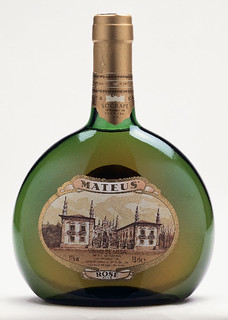 The next wine I drank was Lynne’s fault. She got a wine bottle from her cousin that had been autographed by teen idol
The next wine I drank was Lynne’s fault. She got a wine bottle from her cousin that had been autographed by teen idol 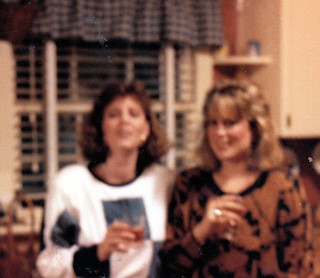 Then came the 1980s and the onslaught of the blush wines. We’re not holding wine here–I’m sure that’s apple juice!–but Kathy and I were known to have a glass of White Zinfandel after a day at work. Or a day at whatever.
Then came the 1980s and the onslaught of the blush wines. We’re not holding wine here–I’m sure that’s apple juice!–but Kathy and I were known to have a glass of White Zinfandel after a day at work. Or a day at whatever. My dearest Becky,
My dearest Becky,